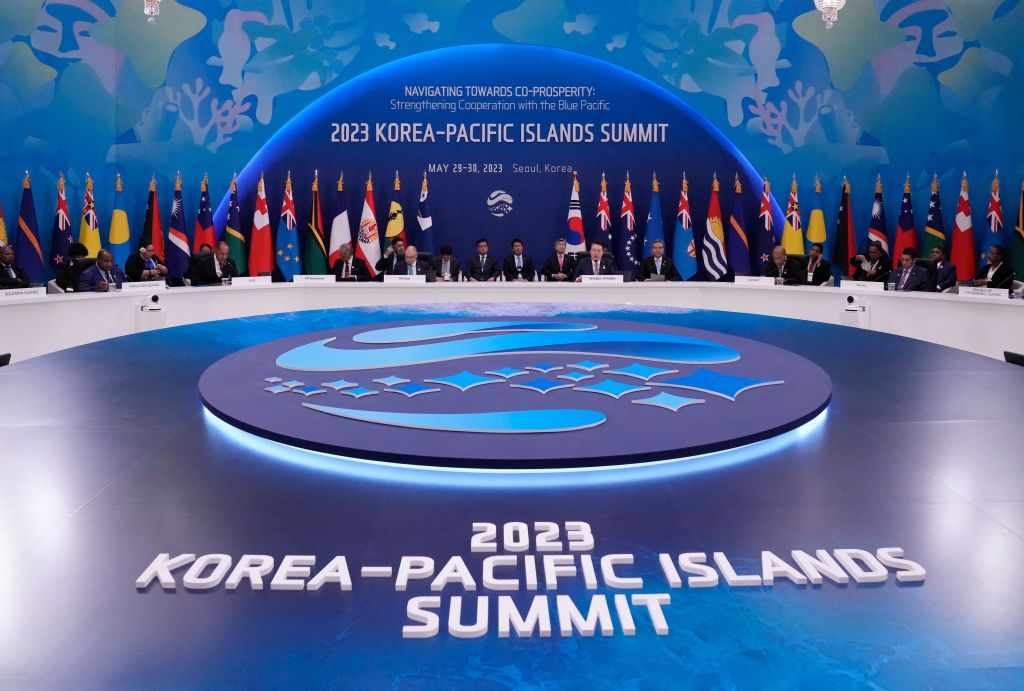
‘I’m trying to figure this out,’ said the journalist who had just phoned. ‘Why is South Korea holding a summit with Pacific leaders?’
That question was undoubtedly asked by more than one journalist, and others, as they sought to analyse the first Korea–Pacific Islands Summit held in Seoul on Monday. Korea hasn’t traditionally played a significant role in the region. While it is a dialogue partner of the Pacific Islands Forum, it directed only US$15.52 million of its US$4.25 billion of development finance there in 2020, representing 0.36% of the total amount spent by all donors. Only 0.3% of Korea’s imports come from the region, primarily from Marshall Islands, New Caledonia, Papua New Guinea and Tonga.
But, like its closest ally, the United States, and its partners, including Australia, Japan and India, Korea recently adopted an ‘Indo-Pacific’ strategy, which has encouraged it to focus more on the ‘Pacific’ part of that region. In its Strategy for a free, peaceful and prosperous Indo-Pacific region, released in December 2022, the Korean government said that it planned on ‘increasing our engagement with the Pacific Island Countries with whom we share the Pacific Ocean’. It later joined the US, Australia and others in the Partners in the Blue Pacific initiative, intended to better coordinate partner assistance.
And Korea is an attractive partner for Pacific island countries—highly developed, democratic and a known supporter of global climate action. At the summit, Korea agreed to double its development assistance to the region and to develop security cooperation in areas such as maritime, climate, energy, cyber and health.
Greater engagement with Korea also offers Pacific island countries another partnership option as they navigate the increasingly polarised strategic environment. Indeed, Korea learned the hard way, during the Korean War, what it means to be caught in the middle of great-power competition—a lesson it’s reminded of daily as it looks across the demilitarised zone at nuclear-armed North Korea.
Korea therefore may have valuable insights to share with Pacific island countries, which have expressed disquiet over the potential impacts of strategic competition playing out in their region. While Korea is an American ally, it has adopted a policy of ‘flexible diplomacy’ to carefully avoid going all-in on American initiatives designed to contain China. For example, the previous progressive Moon Jae-in administration decided against seeking membership of the Quad, and the current conservative Yoon Suk-yeol government has limited its outreach with the Quad to non-traditional security issues. Korea has also indicated that its priority would be defending itself against North Korea rather than assisting the US in the event of a war in the Taiwan Strait.
Notably, Korea’s Indo-Pacific strategy, like ASEAN’s Indo-Pacific Outlook, India’s vision for the Indo-Pacific and Japan’s Indo-Pacific plan, stresses the need for ‘inclusiveness’—a concept absent from the Indo-Pacific strategies of the US and Australia. This reflects that the proximity of Korea and its Asian neighbours to China means they can’t afford the same containment approach—a perception shared by many Pacific island countries.
The Korea summit also offered an opportunity for Pacific island countries to continue to build their relationships in Asia. At the moment, only Papua New Guinea is a member of APEC and an observer of ASEAN, but the Korea summit may help pave the way for greater direct engagement between Asia and the Pacific.
Following hot on the heels of third summit of the Forum for India–Pacific Islands Cooperation and the US–Pacific Islands Forum leaders’ dialogue, the Korea summit also demonstrates the effectiveness of Pacific island countries’ collective diplomacy, particularly under the auspices of the Pacific Islands Forum.
Forum leaders formally adopted the Blue Pacific narrative in their 2017 communiqué to represent ‘a long-term Forum foreign policy commitment to act as one “Blue Continent”’ and to facilitate ‘an assertive Pacific diplomacy’. And they have successfully encouraged partner states to adopt the language of the Blue Pacific narrative (it was incorporated into each of the India, US and Korea summit communications) and to pledge their support for the forum’s 2050 strategy for the Blue Pacific continent. Notably, the 2050 strategy stresses that Pacific island countries strive for ‘inclusive’ partnerships.
And this highlights a tension in the Blue Pacific narrative, and in Korea’s relationships in the Pacific and beyond: managing a preference for inclusiveness alongside the more assertive stance towards China taken by Pacific Islands Forum member Australia, and Korean (and Australian) ally the US. It was telling that, rather than sending Prime Minister Anthony Albanese or Foreign Minister Penny Wong to the summit, Australia sent Deputy Prime Minister Richard Marles—who is also its defence minister. While Marles’s interest in the Pacific islands region is well known and longstanding, the Australian media has focused on his bilateral meetings with Korean President Yoon Suk-yeol and Minister of National Defense Lee Jong-sup, describing his visit as being primarily for ‘high-level defence talks’.
Beyond defence, Korea must also balance the interests of Pacific island countries with those of other partners on issues such as climate change. Korea is Australia’s third-largest export market, particularly for gas and coal. Indeed, in the lead-up to the summit, the Pacific Climate Action Network issued a call for the Korean government to stop supporting fossil-fuel projects in Australia.
Korea’s interest in the Pacific islands region has been welcomed by Pacific leaders. But Korea will find that, like other relatively new players in the region, such as India, its Pacific islands diplomacy involves a challenging balancing act, and that increasingly assertive Pacific island countries will be watching carefully to see whether it stumbles.

